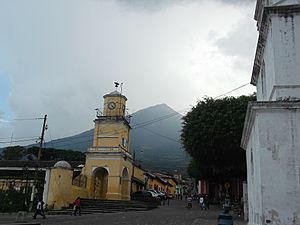Beatriz de la Cueva facts for kids
Quick facts for kids
Beatriz de la Cueva
|
|
|---|---|
| Governor of Santiago de los Caballeros de Guatemala | |
| In office 9 September 1541 – 11 September 1541 |
|
| Lieutenant | Francisco de la Cueva |
| Preceded by | Francisco de la Cueva |
| Succeeded by | Francisco Marroquín |
| Personal details | |
| Born | 1498–1500 Úbeda, Kingdom of Jaén |
| Died | 11 September 1541 (aged c. 41) Santiago de los Caballeros de Guatemala, Spanish Empire |
| Spouse | |
Beatriz de la Cueva de Alvarado (c. 1498 – 11 September 1541) was a Spanish noblewoman. She was known as "La Sinventura," which means "The Unfortunate." She became the governor of the Spanish colony of Guatemala for just a few days in September 1541. Sadly, she died in an earthquake soon after taking office.
Beatriz de la Cueva was the only woman to hold such a high position in a major Spanish colony in Latin America during that time. She is remembered for bringing Spanish house styles and customs to Guatemala. She was buried in the main church of Santiago de los Caballeros de Guatemala.
Her Early Life
Beatriz de la Cueva was born into a noble family, likely between 1498 and 1500. Her hometown was Úbeda in Andalusia, Spain. Her father, Luis de la Cueva, was an important admiral. Her uncle was the Duke of Alburquerque, a very powerful person. Most of her brothers died fighting in Algiers.
Beatriz's sister, Francisca, was married to a famous Spanish explorer and conqueror named Pedro de Alvarado. After Francisca passed away, Alvarado went back to Spain and married Beatriz on October 17, 1538. Their marriage needed special permission from the Pope because they were related through Francisca. Another of Beatriz's uncles, Francisco de los Cobos, was a personal secretary to King Charles I. He helped them get the Pope's approval. He also gave Beatriz a large sum of money as her dowry (a gift from the bride's family).
Becoming Governor of Guatemala

Beatriz and Pedro de Alvarado returned to Guatemala by 1539. She brought many people with her, including 20 maids of honor. In June 1541, Pedro de Alvarado was badly hurt in a battle in Mexico and was dying. He decided that Beatriz should inherit his wealth and his right to rule Guatemala.
News of Alvarado's death reached Beatriz on August 29. She was very sad and ordered all the walls of her palace to be painted black. Beatriz then worked to become her husband's replacement as governor. Even though Alvarado had named her brother Francisco as acting governor, she called a meeting with him, the bishop Francisco Marroquín, and other officials.
Beatriz told them that the royal treasurer wanted to take Alvarado's title. She demanded that they make her governor instead. After a lot of discussion, Beatriz was declared governor the next morning, on September 9, 1541. She signed the official papers as la sin ventura, meaning "the unfortunate," because of her husband's recent death. She quickly made her brother Francisco her assistant, handling daily tasks. However, Beatriz kept all the important powers, like deciding who got wealth and who controlled the local people's labor. This made her the first female governor in the New World.
But not everyone was happy. The royal treasurer and his friends continued to plot against her. When Beatriz found out, she ordered her brother to arrest them. The plotters had planned to take over on September 11, but they hid in an empty house to avoid being caught.
A Tragic End

In the early hours of September 11, 1541, heavy rains and an earthquake caused a wall of the Volcán de Agua's crater to break. Water from the former crater lake rushed down the mountain towards the capital city, Santiago de los Caballeros de Guatemala (now called Ciudad Vieja). This created a huge scar on the mountainside.
Beatriz's three-story stone palace was built next to a stream on the volcano's slope, overlooking the city. When the flood hit, Beatriz grabbed her five-year-old daughter, Anica, and ran to her chapel on the roof. The powerful water swept away some of her servants and her stepdaughter, Leonor, who had run downstairs with other children. Leonor survived by holding onto a tree, but the other children died.
While this was happening, the plotters tried to attack the palace, which was being defended by Francisco and his soldiers. But everyone, including the plotters and soldiers, was swept away by the flood. Beatriz and Anica died when a second earthquake tremor hit, and the roof of the chapel collapsed on them.
Beatriz de la Cueva was buried in the main church of the rebuilt city of Santiago de los Caballeros de Guatemala (now Antigua Guatemala). Bishop Francisco Marroquín insisted on her burial there, even though some people in the area were against it. Later, in 1580, Leonor had Pedro de Alvarado reburied next to Beatriz.
Her Impact
Beatriz de la Cueva is remembered for being the first female colonial governor in the New World, even if only for a short time. She also helped introduce Spanish customs and the Spanish style of building houses into Guatemala.
After her death, some people blamed Beatriz for the disaster. They thought it was a punishment from God for her actions. Her story also became a warning about women holding powerful political positions.
See also
 In Spanish: Beatriz de la Cueva para niños
In Spanish: Beatriz de la Cueva para niños

